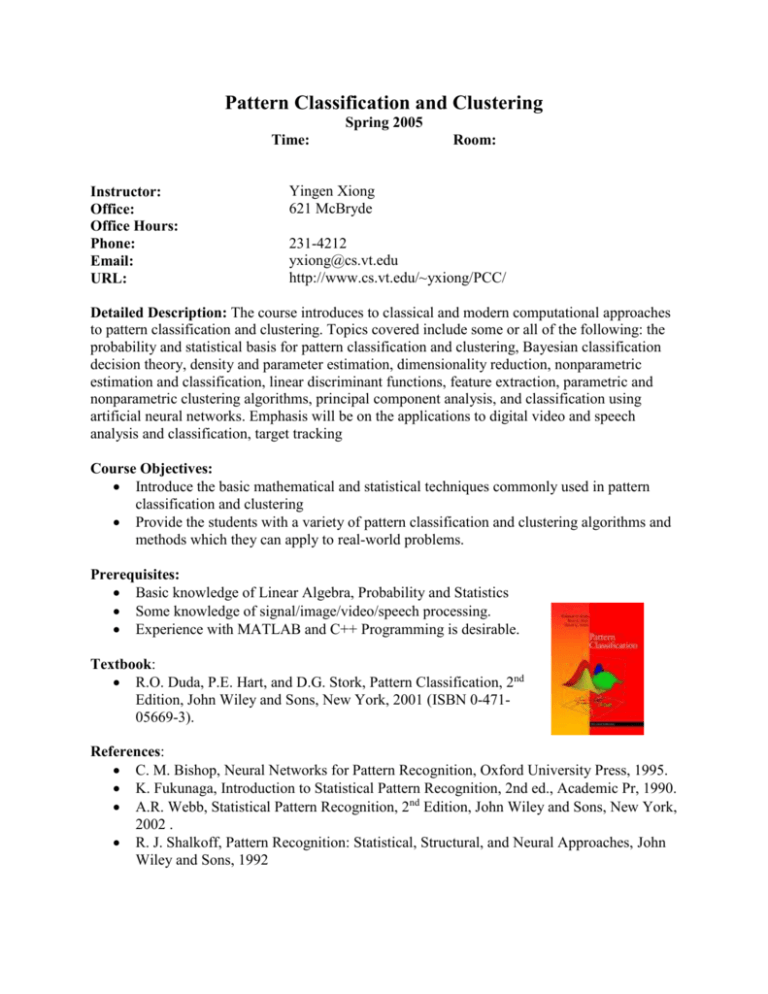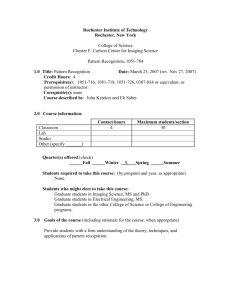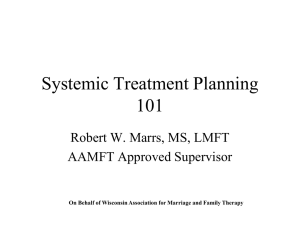Statistical/Neural Pattern Analysis and Classification
advertisement

Pattern Classification and Clustering Spring 2005 Time: Instructor: Office: Office Hours: Phone: Email: URL: Room: Yingen Xiong 621 McBryde 231-4212 yxiong@cs.vt.edu http://www.cs.vt.edu/~yxiong/PCC/ Detailed Description: The course introduces to classical and modern computational approaches to pattern classification and clustering. Topics covered include some or all of the following: the probability and statistical basis for pattern classification and clustering, Bayesian classification decision theory, density and parameter estimation, dimensionality reduction, nonparametric estimation and classification, linear discriminant functions, feature extraction, parametric and nonparametric clustering algorithms, principal component analysis, and classification using artificial neural networks. Emphasis will be on the applications to digital video and speech analysis and classification, target tracking Course Objectives: Introduce the basic mathematical and statistical techniques commonly used in pattern classification and clustering Provide the students with a variety of pattern classification and clustering algorithms and methods which they can apply to real-world problems. Prerequisites: Basic knowledge of Linear Algebra, Probability and Statistics Some knowledge of signal/image/video/speech processing. Experience with MATLAB and C++ Programming is desirable. Textbook: R.O. Duda, P.E. Hart, and D.G. Stork, Pattern Classification, 2nd Edition, John Wiley and Sons, New York, 2001 (ISBN 0-47105669-3). References: C. M. Bishop, Neural Networks for Pattern Recognition, Oxford University Press, 1995. K. Fukunaga, Introduction to Statistical Pattern Recognition, 2nd ed., Academic Pr, 1990. A.R. Webb, Statistical Pattern Recognition, 2nd Edition, John Wiley and Sons, New York, 2002 . R. J. Shalkoff, Pattern Recognition: Statistical, Structural, and Neural Approaches, John Wiley and Sons, 1992 S.M. Kay, Fundamentals of Statistical Signal Processing Estimation Theory, PrenticeHall, Inc. Englewood Cliffs, NJ, 1993. B. Widrow, S.D. Stearns, Adaptive Signal Processing, Englewood Cliffs, N.J. PrenticeHall, 1985. Course Outline: Introduction to Pattern Classification and Clustering Objective of Pattern Classification, Model of the pattern classification process, linear decision function, minimum-distance classification, approaches to pattern classification and clustering: statistical, neural and structural. Review of Some Basic Knowledge Probability and statistics: probability theory, conditional probability and Bayes rule, Random vectors, expectation, correlation, covariance. Linear algebra, linear transformations MATLAB Tutorial Review of some tools which need to be used to complete programming assignments. Students are highly encouraged to use MATLAB to implement their assignments and projects. Bayesian Classification Decision Theory Bayesian decision rules, Minimum error-rate classification, discriminant functions and decision boundaries, Bayes classifier for Gaussian patterns, linear and quadratic classifiers. Density and Parameter Estimation Maximum-likelihood estimation, Bayesian estimation Dimensionality Reduction The curse of dimensionality, principal component analysis, linear discriminants analysis. Nonparametric Estimation and Classification Parzen windows, K-nearest-neighbor classification, Non-parametric classification, density estimation, Parzen estimation. Linear Discriminant functions Linear discriminant, Perceptron learning, optimization by gradient descent, Support Vector Machine Clustering Algorithms Maximum-likelihood estimation and unsupervised learning, Mixture of Gaussian, Kmeans algorithm, hierarchical clustering, component analysis. Introduction to Classification Using Artificial Neural Networks Single-layer networks, multilayer neural networks, feedforward operation, backpropagation algorithm, learning curves, neural networks classifiers. Grading: The course grade will be the weighted sum of four grades. Grading will be straight scale (90-100 A, 80-89 B, 70-79 C, 60-69 D, below 60 F). Homework: There will be 3-5 homework assignments and will require students to implement some of the algorithms covered during the semester and apply them. Homework assignments must be done individually. No collaboration on homework is allowed. Homework assignments will be done in MATLAB Exam: There will be a midterm exam and a final exam. All tests will be closed-books, closed-notes. The final exam may cover material from the entire course, but will emphasize material not covered on the mid-term. Project: The term project is due at the end of the semester and accounts for 40% of the course grade. Students will choose their own problem topic. Students will write a short proposal for the purpose of approval and feedback. It can be a comprehensive literature review or the implementation of the algorithms covered during the semester. Students are encouraged to propose projects related to their own research. To facilitate the completion of the project in a semester, it is advised that teams of 2-3 students work together. Students are highly encouraged to use MATLAB to implement their projects. Projects will be graded by their content (75%) and the quality of a classroom presentation (25%) at the end of the semester. Homework Project Midterm Final Exam 30% 40% 10% 20% Course Schedule Week 1 2 3 4 5 6 7 8 9 10 11 12 13 14 15 Date Topics Readings Assignments/activities Introduction to Pattern Classification and Clustering: Problem, Model, Decision Function, and Approaches Review of Statistics and Probability Review of Random Vectors, Expectation, Correlation, Covariance Review of Linear Algebra, Linear Transformations MATLAB Tutorial: Tool Box and Programming DHS Ch.1 DHS A.4 DHS A4, notes DHS A2 Notes Bayesian Decision Rules, Minimun Error-rate Classification, Discriminant Functions and Decision Boundary DHS Ch. 2 Bayes Classifiers for Gaussian Pattern, Linear and Quadratic Classifiers DHS Ch. 2 Homework#1 due DHS Ch.3 Homework#2 assigned Density and Parameter Estimation: MaximumLikelihood Estimation Density and Parameter Estimation: Bayesian Estimation The Curse of Dimensionality, Fisher Linear Discriminant Analysis Principal Component Analysis Nonparametric Density Estimation Parzen Window, K-nearest Neighbor Estimation Nonparametric Classification, Parzen Estimation Midterm Linear Discriminant, Percepton Learning Optimization by Gradient Descent, Support Vector Machine Mixture of Gaussian, Maximum-likelihood Estimation and Unsupervised Learning K-means Algorithm Hierarchical Clustering Componen Analysis Single Layer Networks Multilayer Neural Networks Neural Networks Classifiers Parameter Optimization Algorithm II Parameter Optimization Algorithm I Project Presentation I Project Presentation II Course Review Final Exam, 2 hours Homework#1 assigned DHS Ch. 3 DHS Ch. 3 DHS Ch. 3 DHS Ch.4 DHS Ch. 4 DHS Ch. 4 Homework#2 due Homework#3 assigned Midterm DHS Ch. 5 DHS Ch. 5 DHS Ch. 10 DHS Ch. 10 DHS Ch. 10 DHS Ch. 10 DHS Ch. 6 DHS Ch. 6 DHS Ch. 6 CMB Ch. 7 CMB Ch. 7 Homework#3 due Term project proposal due Project presentation I Project presentation II Final Exam Note: 1. DHS--- R.O. Duda, P.E. Hart, and D.G. Stork, Pattern Classification, 2nd Edition, John Wiley and Sons, New York, 2001 2. CMB---C. M. Bishop, Neural Networks for Pattern Recognition, Oxford University Press, 1995






